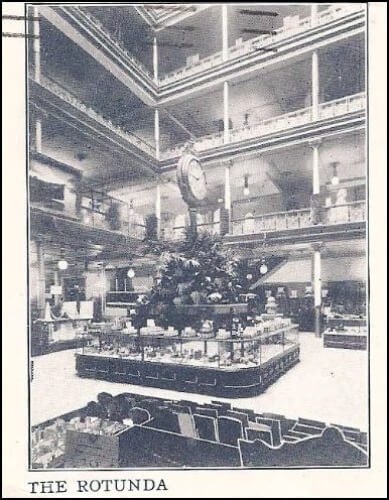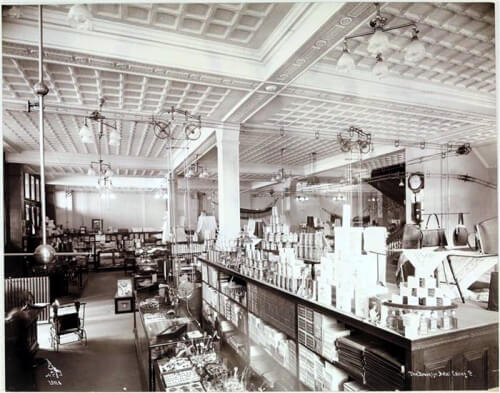Walkabout: Brooklyn’s Abraham & Straus
Read Part 2 of this story. In today’s fragile economy and cultural hurly-burly, holiday shopping has lost its charm and whimsy to price slashing, in your face, heavy duty bargain hunting. Christmas shopping is no longer the time to lovingly and carefully choose the perfect gift for a loved one; it’s a time to knock…

Carriage entrance on Livingston St. Photo: Plummer & Assoc.
Read Part 2 of this story.
In today’s fragile economy and cultural hurly-burly, holiday shopping has lost its charm and whimsy to price slashing, in your face, heavy duty bargain hunting. Christmas shopping is no longer the time to lovingly and carefully choose the perfect gift for a loved one; it’s a time to knock someone out in order to score a flat screen television for a bargain basement price, and make a profit for cash starved retailers.
When I was a child, (dinosaur alert!) the classic hunt for a perfect present for a parent or sibling took place in a department store, one of those magical places where a child would be enraptured by what seemed to be an immense store full of glittery and bright Christmas decorations, fanciful wrapped boxes of presents stacked everywhere, and Santa Claus in the toy department. All amidst departments that sold anything you could possibly imagine, staffed by kind people who were there to make your dreams come true. This was true even in the small town I grew up in, where the stores were not really immense by any stretch of the imagination, but nowhere was it more true than in New York City.
Retail has changed a great deal, so for those who did not grow up in Brooklyn, or only moved here in the last ten or fifteen years, it’s hard to visualize the shopping mecca that Fulton Street once was, only a few generations ago. Even those of us who have been here a while would have a hard time imagining the Fulton Street of a hundred years ago, when some of the largest and most impressive department stores of all time lined the streets, offering wonders to behold and purchase. Abraham and Straus was the king of Brooklyn’s large and profitable emporiums, a store with quite a story to tell.
From a stand in the village square to a shop on a merchant’s row, the retail establishment is almost as old as civilization. Before there were department stores, there were specialty shops, which sold every kind of goods imaginable, literally from axes to zippers. (I am well aware that zippers are a 20th century invention, so no nit-picking! Just run with the A-Z premise.) The department store, by the definition of the very name, would combine the goods found in small specialty shops under one roof. This would be “one stop shopping” at its nadir. Someone would have to be first, and that man was Alexander Turner Stewart, an Irish immigrant who made it big in New York City.
The first department store in the United States was A.T. Stewart’s Marble Palace, in Manhattan, at 280 Broadway, at the corner of Chambers Street. It opened in 1846. Known today as the Sun Building, the building now holds city offices, and is a National Historic Landmark. From the very beginning, Stewart, and the many who followed him, realized that their fortunes were based on catering to the shopping needs of women.
Like most of the first department store founders of the mid to late nineteenth century, Stewart started out in dry goods; fabrics and notions used for clothing for the entire family, as well as cloth used for upholstery, draperies, tabletop, and any other use. Stewart’s Marble Palace specialized in women’s clothing imported from Europe, and was the first store to have fashion shows, which took place on the second floor. In 1862, Stewart moved uptown to a huge, block long and wide store on Broadway and 10th Street, across from Grace Episcopal Church, the largest store of its kind to date, anywhere.
The idea of “departments” in these large stores didn’t take long. Soon places like Stewart’s were carrying not only women’s dresses, but had branched out to other kinds of women’s clothing, such as outerwear, shoes, hats and gloves, underwear, and other accessories. The convenience soon led to these stores carrying children’s wear, then men’s wear, followed by goods like jewelry and cosmetics, then furniture, dishes, silverware, bedding, table cloths and other cloth goods, and other items for the home.
At the turn of the 20th century, many department stores also had a fine art department, a fancy grocery emporium, piano department, lamps and lighting, appliances, silver department, rugs and carpet, and almost anything else you can think of. Smart retailers, especially if they had the room, also had beauty salons, enormous fitting and custom-made dress salons, and that most important of amenities, a well-appointed lunch, or tea room, where tired ladies could have a bite to eat and a bit of a rest before continuing to shop. It’s no wonder that most of the successful department stores in New York and other cities were so large. They needed the room.
Here in Brooklyn, Abraham and Straus was started as Wechsler & Abraham, founded by Joseph Wechsler and Abraham Abraham in 1865. Their first store was on Fulton Street, near Tillary Street, at the time, the retail hub of the area. In 1883, the store moved into the newly constructed Wheeler Building, an ornate Second Empire cast iron fronted store further down on Fulton Street, near the corner of Hoyt Street, in an area that was fast becoming Brooklyn’s new shopping district. By 1885, they had expanded further into the old Leibmann Brothers store next door.
They hired George L. Morse, a prominent Brooklyn architect, to design yet another addition to the building, and that year, he designed the handsome seven story annex on the corner of Gallatin Place that faces Livingston Street. Many consider this to be the finest of the group of buildings that make up the store. It was used as a connector to all of the buildings by means of an indoor carriage entrance to the store, and its upper floors were warehouse space.
By 1893, Wechsler and Abraham became Abraham and Straus, when Wechsler sold out to the Straus brothers, Isidor and Nathan. They were already the principal owners of R.H.Macy & Co. of Manhattan. They also took on another partner, Simon F. Rothschild, who was an active partner in the growth of the store. The new team took the store to its greatest heights. One of the first things they did was buy another adjoining building, the Vosburgh Building, on Fulton Street, designed in 1888 by the Parfitt Brothers for the Vosburgh Manufacturing Company, one of Brooklyn’s largest gas lighting fixture companies. Abraham and Straus now had the entire block front from Hoyt to Gallatin Place, on both Fulton and Livingston Streets, a full city block of store. Abraham and Straus’ golden years were about to begin.
By the time the Straus’ bought into the store, it already had 2,000 employees. Seven years later, as the new century dawned, Abraham and Straus had over 4,500 employees, and was one of the largest stores in the state. In 1912, Isidor and Ida Straus died on the Titanic. Their decision to stay together to the end, instead of Ida leaving, as many of the wealthy women were able to do, is the stuff of tragic sacrifice and legend. In 1915, their son, Percy Sheldon Straus, married Abraham Abraham’s daughter, and the decision was made to split the family holdings, with Nathan’s family running Abraham and Straus, and Isidor’s family running R.H. Macy & Co.
For the early 20th century ladies of Brooklyn, shopping at Abraham and Straus was an indulgence of riches and luxury. If you came to the store by carriage, you would be driven through the Livingston Street entrance, into an indoor porte cochere. Upon entering the store, the expansive five story courtyard awaited, with departments on every level.
The remnants of this open courtyard can still be glimpsed in the men’s department of today’s store. If a customer entered the store from Fulton Street, they also had a visual treat. A large three story arched entrance, long ago filled in, and opened up upon the sky lighted interior courtyard. It was so fabulous, for many, it probably cancelled out the noise and dirt of the Fulton Street elevated train running alongside the store. The entrance can be seen in a postcard dated from 1904, and the courtyard from another postcard of the same year.
The store’s interior was fitted with display cases and woodwork of black walnut, ash and quartered oak, all interspersed by black iron columns with a bronze finish. Along with the expected lady’s departments, Abraham and Straus also had a complete vaulted silver room and a fully stocked gourmet food emporium in the basement. The most modern conveniences in store management were employed, including the use of an elaborate pulley system that carried money to and from a central banking room. A 1910 photo of the interior of the store clearly shows the mechanisms and tracks for this state of the art system, running at ceiling level. Many stores also had a pneumatic tube system that had the same purpose.
The money travelling along the pulleys was indicative of the success of the store. Only Loesser’s, the other mega-emporium a couple of blocks down Fulton Street was a close rival. As our story continues next time, Abraham and Straus continues to grow and build, as Art Deco replaces Victorian cast iron. The department store also was a major tool in the empowerment of women in the 20th century. We’ll take a look at that, too.











I miss A & S- always loved the building. It’s very beautiful if you look up, and not at the appalling ground floor exteriors. I agree with crownlfc- maybe retailers should read this and take a hint.
There are still plenty of beautiful department stores in most downtowns. I can’t really explain what happened in downtown Brooklyn. It is an unusual story. Even as the Borough was gaining population and wealth, the center was sinking and becoming more degraded. Someone should study it and figure out what forces were at play. I suspect it was an unsavory combination of forces that included organized crime as a major player.